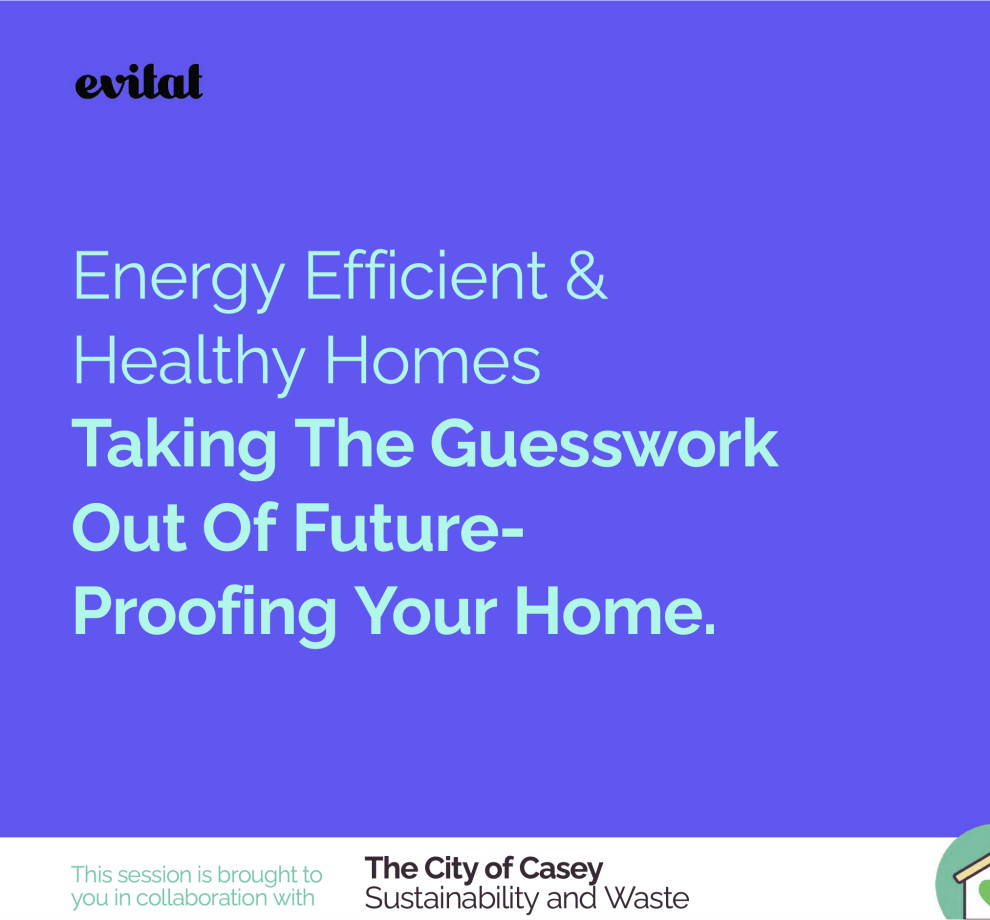Energy-Efficient & Healthy Homes: Taking the Guesswork Out of Future-Proofing Your Home

Simone had the pleasure of supporting Sonja from Evitat at two events for The City of Casey, where they explored what it truly means to create energy-efficient and healthy homes.
These events provided valuable insights into how we can future-proof our homes and make them more comfortable, cost-effective, and sustainable.
Understanding the Issues in Older Homes
Sonja kicked things off by addressing the common issues we experience in older homes:
- Mould and dampness
- Cold, draughty conditions in winter
- Overheating in summer
- Excessively high energy bills
- General discomfort all year round
These challenges highlight the importance of rethinking how our homes are designed and upgraded. Sonja then posed a crucial question: What is a climate-ready home, and why does it matter?
What is a Climate-Ready Home?
A climate-ready home is an efficient home—one that reduces the need for heating and cooling appliances, even during extreme weather conditions. This not only lowers energy bills but also reduces the strain on the energy grid. With global temperatures rising, the need for climate-ready homes has never been more urgent.
The Shift to Renewable Energy
Sonja highlighted how much Australia’s climate has warmed over the years and how this shift is occurring worldwide. She also emphasised the benefits of utilising solar and wind energy, which are abundant and sustainable, unlike finite fossil fuels like coal, oil, and gas that are subject to market volatility.
Mythbusting:
Common Misconceptions About Energy and Gas
Sonja tackled some common myths surrounding gas and renewables:
Are we running out of gas?
No! In fact, 72% of Australia’s gas is exported overseas. Only a small portion is used domestically—3% for residential use, 8.2% for electricity production, 6.6% for manufacturing, and just 1% for commercial and industrial purposes.
Are renewables making gas prices expensive?
No. Gas prices are driven by exports and the global market, not renewable energy.
Is the push for renewables just about emissions?
While reducing emissions is critical in tackling climate change, it’s also about health. Studies show that gas appliances contribute to asthma and other respiratory issues, making a transition away from gas beneficial for overall well-being.
Future-Proofing Our Homes: Why Now is the Time to Act
Sonja provided a practical renovation plan for making homes more energy-efficient and comfortable:
- Improve thermal comfort by addressing drafts, insulation, home design, orientation, windows, and ventilation.
- Go off-gas by switching to all-electric appliances.
- Share knowledge within the community to inspire and educate others.
The Importance of Proper Insulation
Felicia from Enviroflex joined the discussion, explaining why insulation is crucial for energy efficiency. Unfortunately, many insulation installations are rushed, leading to poor performance. Felicia highlighted the key benefits of properly installed insulation and what homeowners should look for to ensure they’re getting the best results.
The Financial Benefits of Going Off-Gas
Sonja continued by discussing the long-term savings of going off-gas, demonstrating how much money homeowners can save on energy bills over time.
Understanding the Scorecard Assessment
James from Australian Energy Assessment introduced the Scorecard—a government tool designed to help homeowners make informed renovation decisions:
- Rates a home’s energy use
- Identifies ways to improve comfort and running costs
- Helps tailor and quantify the value of upgrades
- Simulates upgrades and provides before-and-after renovation ratings
- Assesses key appliances and the home’s thermal efficiency
Green Loans: Financing Your Energy Upgrades
Sonja also covered green loans—a great way to access reduced mortgage rates when undertaking energy efficiency upgrades. She shared real-life case studies where homeowners saved significant amounts over the life of their mortgage by making sustainable improvements.
A Real-Life Case Study: Simone’s Home Transformation
Simone then shared her personal journey of upgrading a typical 2-bedroom brick veneer unit from a 0.8-star rating to an 8.4-star energy-efficient family home—without increasing its size.
Key upgrades included:
- Insulating all external walls, roof, floor, and ceiling
- Replacing single-glazed aluminium windows with double-glazed UPVC windows (imported from Germany due to local affordability issues at the time)
- Rearranging rooms to create a more functional layout, turning a 2-bedroom, 1-bathroom home into a 3-bedroom, 2-bathroom home with a European laundry
- Using non-toxic finishes throughout
- Installing energy-efficient appliances and LED lighting
- Adding a small solar PV system
By the time the renovations were completed, the home used far less energy with five people living in it than it originally did with only two!
The Importance of a Master Plan
Simone emphasised that while renovating or upgrading an existing home can seem overwhelming, the key is to develop a master plan:
- Identify all potential improvements.
- Determine which upgrades are most cost-effective.
- Understand what can be done DIY and what requires professional help.
- Use the Scorecard assessment as a starting point.
- Prioritise tasks and stage upgrades over time if needed.
- Take advantage of resources like the Evitat community and Evitat Logbook, which provide tools to track your home’s energy performance, plan upgrades, and access sustainable products and professionals.
A Successful and Engaging Event
The two events were packed with valuable insights, practical advice, and engaging discussions with attendees. With rising energy costs and increasing climate challenges, making our homes more energy-efficient, comfortable, and future-proof is more important than ever.
If you’re considering an upgrade, renovation, or new build, taking small steps now can lead to big savings and a healthier home in the long run.
Looking to get started on your own home transformation? Reach out to us for a free consultation and take the first step toward a more sustainable, energy-efficient future!
